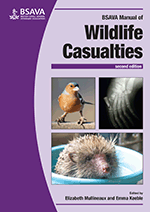
Full text loading...

Long-legged wading birds are relatively uncommon wildlife rehabilitation patients in the UK; oystercatchers, grey heron, coots and moorhens are the most likely waders to be admitted. The most common reasons for presentation are trauma, including firearm injuries, fishing hook and line injuries, power line collisions, and beak trauma, and apparently orphaned youngsters. This chapter covers: ecology and biology; anatomy and physiology; capture, handling and transportation; clinical assessment; first aid and hospitalization; anaesthesia and analgesia; specific conditions; therapeutics; husbandry; rearing of young wading birds; rehabilitation and release; and legal considerations.
Wading birds, Page 1 of 1
< Previous page | Next page > /docserver/preview/fulltext/10.22233/9781910443316/9781910443316.25-1.gif

Full text loading...
















